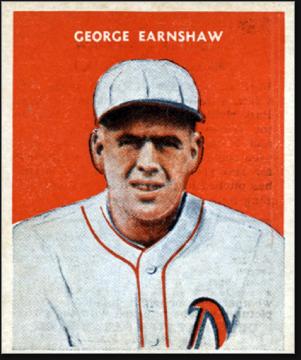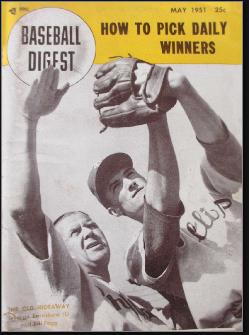
George Earnshaw
Sport: Baseball
Born: February 15, 1900
Died: December 1, 1976
Town: Montclair
George Livingston Earnshaw was born February 15, 1900 in New York City and grew up in Upper Montclair. The son of an advertising executive, he was a bright and athletic boy who grew to a height of 6’4” and excelled as a football, baseball and basketball player. Family connections enabled George to attend the Swarthmore prep school in Main Line Philadelphia, and he went on to attend Swarthmore College. He pitched for the baseball team and played the line for the football team.
George had a bright future in business waiting for him, and married well. His wife, Grace, was the daughter of the comptroller of the Pennsylvania Railroad. But the near future held promise on the baseball diamond. A Swarthmore teammate recommended him to Jack Dunn, the owner of the minor-league Baltimore Orioles. Dunn, well known to all at this point as the man who signed Babe Ruth out of reform school, made a tidy living developing young talent and selling it to big-league clubs—most often the Philadelphia A’s. Dunn tried to sign George, but he demanded a salary that was higher than many major leaguers were getting. Dunn refused, so George took a job with a barge company in Newark.
Two years later, the company closed and George decided to give baseball another try. He had kept in shape playing in semipro games and had also dabbled in insurance. For the remainder of his career, he would operate and insurance office in between seasons.
George signed with the Orioles and became their star hurler. He could be wild at times, but just wild enough to keep enemy batters from digging in in the pre-batting helmet days. Dunn turned down several offers or George until George finally threatened to quit if Dunn didn’t deal him to a major league club. He did so during the 1928 season, closing an $80,000 deal with Connie Mack’s A’s.
George threw directly overhand. His fastball stayed low in the strike zone. He loved to challenge hitters, and was prone to giving up home runs when his pitched were up. When George was on, he was extremely difficult to hit—he threw a “fast” breaking pitch that looked exactly like his fastball before the bottom dropped out. Most of his strikeouts came on this pitch, with batters often swinging over pitches in the dirt, thinking it was his heater. Umpire Jocko Conlon compared this pitch to Sandy Koufax’s hard curve. He also had a serviceable changeup.
In Philadelphia, Mack was building a ball club to threaten the death grip of the Yankees on the American League. In 1929, George won went 24–8 and the A’s won the pennant by 18 games. George led the AL in victories and gave up the fewest hits per 9 innings, and was second in the league to teammate Lefty Grove with 149 strikeouts. George started two games in the World Series against the Cubs, winning one, in a five-game victory over the Cubs. One of the key players on the championship team was outfielder Mule Haas, a fellow Montclair resident.
George won 22 games in 1930 and finished second again to Grove in strikeouts, helping the A’s capture their second straight pennant. George was untouchable in the World Series against the Cardinals. He pitched 22 consecutive scoreless innings, winning Game 2 and Game 6, and also twirling seven scoreless innings in Game 5. The A’s won 4 games to 2, and rival manager Gabby Street said Philly just had “too much Earnshaw.”
George went 21–7 in 1931 as the A’s won their third straight pennant. The World Series featured a rematch with the Cardinals, and this time St. Louis came out on top. The difference was Pepper Martin’s aggressive base running. He stole four bases with George on the mound.
George went 19–13 in 1932 and saw his salary cut in half—partially for his so-so season but also because the A’s were struggling as the Great Depression worsened. He did not respond well to this cut, and there was increased friction with Mack, who believed George was spending too much of his time and salary in nightclubs, and was out of shape. He sold George to the White Sox after the 1933 season. George won a team-best 14  games in 1934 but Chicago sold him to the Dodgers in the off-season. In Brooklyn, he roomed with fellow night owl Dazzy Vance until the team packed him off to the Cardinals in July. When the Cards tried to ship him to the minors, he decided it was time to devote himself to his insurance career. games in 1934 but Chicago sold him to the Dodgers in the off-season. In Brooklyn, he roomed with fellow night owl Dazzy Vance until the team packed him off to the Cardinals in July. When the Cards tried to ship him to the minors, he decided it was time to devote himself to his insurance career.
In 1941, with World War II on the horizon, the U.S. Navy charged boxing champion Gene Tunney with recruiting prominent athletes for its physical fitness program. George enlisted and was made a lieutenant, but soon tired of coaching and training. In 1943, he became a gunnery officer on the new aircraft carrier Yorktown. He was commended by Admiral Nimitz for downing three Japanese torpedo planes during Operation Hailstone, which destroyed the enemy naval base at Truk. George’s son, George Jr., who pitched for Penn State, left school to join the Army and became a jungle warfare instructor in the Philippines. George retired from active duty in 1947 with the rank of Commander.
Goerge returned to Philadelphia and went to work in the Phillies’ front office and later served as pitching coach for the famous Whiz Kids of 1950. One of his innovations was to teach young hurlers to chart pitches between starts, and to analyze their own games pitch-by-pitch. After the 1951 season, George bought a farm near Hot Springs, Arkansas. He had some dealings with the local minor league team but by the 1960s he was through with baseball. He passed away at the age of 76.
|
|
|